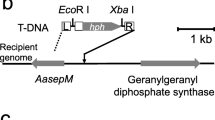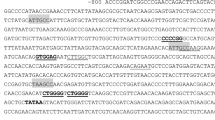Abstract
The cellobiose- and cellulose-responsive induction of the FIII-avicelase (cbhI), FII-carboxymethyl cellulase (cmc2), and FIa-xylanase (xynIa) genes is not regulated by XlnR in Aspergillus aculeatus, which suggests that this fungus possesses an unknown cellulase gene-activating pathway. To identify the regulatory factors involved in this pathway, we constructed a random insertional mutagenesis library using Agrobacterium tumefaciens-mediated transformation of A. aculeatus NCP2, which harbors a transcriptional fusion between the cbhI promoter (P CBHI ) and the orotidine 5′-phosphate decarboxylase gene (pyrG). Of the ~6,000 transformants screened, one 5-FOA-resistant transformant, S4-22, grew poorly on cellulose-containing media and exhibited reduced cellobiose-induced expression of cbhI. Southern blot analysis and nucleotide sequencing of the flanking regions of the T-DNA inserted in S4-22 indicated that the T-DNA was inserted within the coding region of a previously unreported Zn(II)2Cys6-transcription factor, which we designated the cellobiose response regulator (ClbR). The disruption of the clbR gene resulted in a significant reduction in the expression of cbhI and cmc2 in response to cellobiose and cellulose. Interestingly, the cellulose-responsive induction of FI-carboxymethyl cellulase (cmc1) and FIb-xylanase (xynIb) genes that are under the control of XlnR, was also reduced in the clbR-deficient mutant, but there was no effect on the induction of these genes in response to d-xylose or l-arabinose. These data demonstrate that ClbR participates in both XlnR-dependent and XlnR-independent cellobiose- and cellulose-responsive induction signaling pathways in A. aculeatus.









Similar content being viewed by others
References
Adachi H, Tani S, Kanamasa S, Sumitani J, Kawaguchi T (2009) Development of a homologous transformation system for Aspergillus aculeatus based on the sC gene encoding ATP-sulfurylase. Biosci Biotechnol Biochem 73:1197–1199
Andersen CL, Jensen JL, Ørntoft TF (2004) Normalization of real-time quantitative reverse transcription-PCR data: a model-based variance estimation approach to identify genes suited for normalization, applied to bladder and colon canser data sets. Cancer Res 64:5245–5250
Aro N, Saloheimo A, Ilmen M, Penttilä M (2001) AceII, a novel transcription activator involved in regulation of cellulase and xylanase genes of Trichoderma reesei. J Biol Chem 276:24309–24314
Aro N, Pakula T, Penttilä M (2005) Transcriptional regulation of plant cell wall degradation by filamentous fungi. FEMS Microbiol Rev 29:719–739
Battaglia E, Hansen S, Leendertse A, Madrid S, Mulder H, Nikolaev I, de Vries R (2011a) Regulation of pentose utilisation by AraR, but not XlnR, differs in Aspergillus nidulans and Aspergillus niger. Appl Microbiol Biotechnol 91:387–397
Battaglia E, Visser L, Nijssen A, van Veluw GJ, Wösten HAB, de Vries RP (2011b) Analysis of regulation of pentose utilisation in Aspergillus niger reveals evolutinary adaptations in Eurotiales. Stud Mycol 69:31–38
Brunner K, Lichtenauer A, Kratochwill K, Delic M, Mach R (2007) Xyr1 regulates xylanase but not cellulase formation in the head blight fungus Fusarium graminearum. Curr Genet 52:213–220
Coradetti ST, Craig JP, Xiong Y, Shock T, Tian C, Glass NL (2012) Conserved and essential transcription factors for cellulase gene expression in ascomycete fungi. Proc Natl Acad Sci USA 109:7397–7402
Cove DJ (1976a) Chlorate toxicity in Aspergillus nidulans—selection and characterization of chlorate resistant mutants. Heredity 36:191–203
Cove DJ (1976b) Chlorate toxicity in Aspergillus nidulans—studies of mutants altered in nitrate assimilation. Mol Gen Genet 146:147–159
Endo Y, Yokoyama M, Morimoto M, Shirai K, Chikamatsu G, Kato N, Tsukagoshi N, Kato M, Kobayashi T (2008) Novel promoter sequence required for inductive expression of the Aspergillus nidulans endoglucanase gene eglA. Biosci Biotechnol Biochem 72:312–320
Gomi K, Akeno T, Minetoki T, Ozeki K, Kumagai C, Okazaki N, Iimura Y (2000) Molecular cloning and characterization of a transcriptional activator gene, amyR, involved in the amylolytic gene expression in Aspergillus oryzae. Biosci Biotechnol Biochem 64:816–827
Goosen T, Bloemheuvel G, Gysler C, Debie D, Vandenbroek H, Swart K (1987) Transformation of Aspergillus niger using the homologous orotidine-5′-phosphate decarboxylase gene. Curr Genet 11:499–503
Karaffa L, Fekete E, Gamauf C, Szentirmai A, Kubicek C, Seiboth B (2006) d-Galactose induces cellulase gene expression in Hypocrea jecorina at low growth rates. Microbiology 152:1507–1514
Karpichev I, Small G (1998) Global regulatory functions of Oaf1p and Pip2p (Oaf2p), transcription factors that regulate genes encoding peroxisomal proteins in Saccharomyces cerevisiae. Mol Cell Biol 18:6560–6570
Krysan PJ, Young JC, Sussman MR (1999) T-DNA as an insertional mutagen in Arabidopsis. Plant Cell 11:2283–2290
Kubicek CP, Penttilä ME (1998) Regulation of production of plant polysaccharide degrading enzymes by Trichoderma. In: Harman GE, Kubicek CP (eds) Trichoderma and Gliocladium, vol 2. Taylor and Francis, London, pp 49–72
Kunitake E, Tani S, Sumitani J, Kawaguchi T (2011) Agrobacterium tumefaciens-mediated transformation of Aspergillus aculeatus for insertional mutagenesis. AMB Express 1:46
McDonnell AV, Jiang T, Keating AE, Berger B (2006) Paircoil2: improved prediction of coiled coils from sequence. Bioinformatics 22:356–358
Morikawa Y, Ohashi T, Mantani O, Okada H (1995) Cellulase induction by lactose in Trichoderma reesei PC-3-7. Appl Microbiol Biotech 44:106–111
Murao S, Kanamoto J, Arai M (1979) Isolation and identification of a cellulolytic enzyme producing microorganism. J Ferment Technol 57:151–156
Nitta M, Furukawa T, Shida Y, Mori K, Kuhara S, Morikawa Y, Ogasawara W (2012) A new Zn(II)2Cys6-type transcription factor BglR regulates β-glucosidase expression in Trichoderma reesei. Fungal Genet Biol 49:388–397
Noël J, Turcotte B (1998) Zinc cluster proteins Leu3p and Uga3p recognize highly related but distinct DNA targets. J Biol Chem 273:17463–17468
Punt PJ, Zegers ND, Busscher M, Pouwels PH, van den Hondel CA (1991) Intracellular and extracellular production of proteins in Aspergillus under the control of expression signals of the highly expressed Aspergillus nidulans gpdA gene. J Biotech 17:19–33
Sakamoto R, Arai M, Murao S (1985) Enzymatic properties of three β-glucosidase from Aspergillus aculeatus no. F-50. Agric Biol Chem 49:1283–1290
Stricker A, Grosstessner-Hain K, Würleitner E, Mach R (2006) Xyr1 (xylanase regulator 1) regulates both the hydrolytic enzyme system and d-xylose metabolism in Hypocrea jecorina. Eukaryot Cell 5:2128–2137
Stricker A, Steiger M, Mach R (2007) Xyrl receives the lactose induction signal and regulates lactose metabolism in Hypocrea jecorina. FEBS Lett 581:3915–3920
Suarez T, Dequeiroz M, Oestreicher N, Scazzocchio C (1995) The sequence and binding specificity of UaY, the specific regulator of the purine utilization pathway in Aspergillus nidulans, suggest an evolutionary relationship with the PPR1 protein of Saccharomyces cerevisiae. EMBO J 14:1453–1467
Sun J, Tian C, Diamond S, Glass NL (2012) Deciphering transcriptional regulatory mechanisms associated with hemicellulose degradation in Neurospora crassa. Eukaryot Cell 11:482–493
Tani S, Katsuyama Y, Hayashi T, Suzuki H, Kato M, Gomi K, Kobayashi T, Tsukagoshi N (2001) Characterization of the amyR gene encoding a transcriptional activator for the amylase genes in Aspergillus nidulans. Curr Genet 39:10–15
Tani S, Kanamasa S, Sumitani J, Arai M, Kawaguchi T (2012) XlnR-independent signaling pathway regulates both cellulase and xylanase genes in response to cellobiose. Curr Genet 58:93–104
Todd R, Andrianopoulos A (1997) Evolution of a fungal regulatory gene family: the Zn(II)2Cys6 binuclear cluster DNA binding motif. Fungal Genet Biol 21:388–405
Tsuji G, Fujii S, Fujihara N, Hirose C, Tsuge S, Shiraishi T, Kubo Y (2003) Agrobacterium tumefaciens-mediated transformation for random insertional mutagenesis in Colletotrichum lagenarium. J Gen Plant Pathol 69:230–239
van Peij N, Gielkens M, de Vries R, Visser J, de Graaff L (1998a) The transcriptional activator XlnR regulates both xylanolytic and endoglucanase gene expression in Aspergillus niger. Appl Environ Microbiol 64:3615–3619
van Peij N, Visser J, de Graaff L (1998b) Isolation and analysis of xlnR, encoding a transcriptional activator co-ordinating xylanolytic expression in Aspergillus niger. Mol Microbiol 27:131–142
Acknowledgments
This work was supported by a Grant-in-Aid for Young Scientists (B) (20780058) and a Grant-in-Aid for JSPS Fellows (23‧10697).
Author information
Authors and Affiliations
Corresponding author
Rights and permissions
About this article
Cite this article
Kunitake, E., Tani, S., Sumitani, Ji. et al. A novel transcriptional regulator, ClbR, controls the cellobiose- and cellulose-responsive induction of cellulase and xylanase genes regulated by two distinct signaling pathways in Aspergillus aculeatus . Appl Microbiol Biotechnol 97, 2017–2028 (2013). https://doi.org/10.1007/s00253-012-4305-8
Received:
Revised:
Accepted:
Published:
Issue Date:
DOI: https://doi.org/10.1007/s00253-012-4305-8




